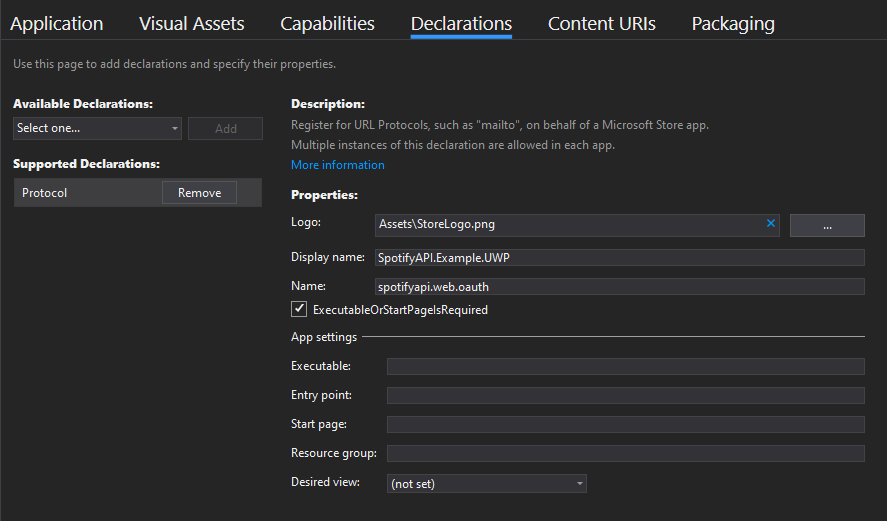Implicit Grant
Implicit grant flow is for clients that are implemented entirely using JavaScript and running in the resource owner’s browser. You do not need any server-side code to use it. Rate limits for requests are improved but there is no refresh token provided. This flow is described in RFC-6749.
This flow is useful for getting a user access token for a short timespan.
Existing Web-Server
If you are already in control of a Web-Server (like ASP.NET), you can start the flow by generating a login uri:
// Make sure "http://localhost:5543" is in your applications redirect URIs!
var loginRequest = new LoginRequest(
new Uri("http://localhost:5543"),
"ClientId",
LoginRequest.ResponseType.Token
)
{
Scope = new[] { Scopes.PlaylistReadPrivate, Scopes.PlaylistReadCollaborative }
};
var uri = loginRequest.ToUri();
// Redirect user to uri via your favorite web-server
When the user is redirected to the generated uri, they will have to login with their Spotify account and confirm that your application wants to access their user data. Once confirmed, they will be redirected to http://localhost:5543 and the fragment identifier (# part of URI) will contain an access token.
Note, this parameter is not sent to the server! You need JavaScript to access it.
Using custom Protocols
This flow can also be used with custom protocols instead of http/https. This is especially interesting for UWP apps, since your able to register custom protocol handlers quite easily.

The process is very similar, you generate a uri and open it for the user:
// Make sure "spotifyapi.web.oauth://token" is in your applications redirect URIs!
var loginRequest = new LoginRequest(
new Uri("spotifyapi.web.oauth://token"),
"ClientId",
LoginRequest.ResponseType.Token
)
{
Scope = new[] { Scopes.PlaylistReadPrivate, Scopes.PlaylistReadCollaborative }
};
var uri = loginRequest.ToUri();
// This call requires Spotify.Web.Auth
BrowserUtil.Open(uri);
After the user has logged in and consented your app, your UWP app will receive a callback:
protected override void OnActivated(IActivatedEventArgs args)
{
if (args.Kind == ActivationKind.Protocol)
{
ProtocolActivatedEventArgs eventArgs = args as ProtocolActivatedEventArgs;
var publisher = Mvx.IoCProvider.Resolve<ITokenPublisherService>();
// This Uri contains your access token in the Fragment part
Console.WriteLine(eventArgs.Uri);
}
}
For a real example, have a look at the Example.UWP, Example.ASP or Example.ASPBlazor
Using Spotify.Web.Auth
For cross-platform CLI and desktop apps (non UWP apps), custom protocol handlers are sometimes not an option. The fallback here is a small cross-platform embedded web server running on http://localhost:5543 serving JavaScript. The JavaScript will parse the fragment part of the URI and sends a request to the web server in the background. The web server then notifies your appliciation via an event.
private static EmbedIOAuthServer _server;
public static async Task Main()
{
// Make sure "http://localhost:5543/callback" is in your spotify application as redirect uri!
_server = new EmbedIOAuthServer(new Uri("http://localhost:5543/callback"), 5543);
await _server.Start();
_server.ImplictGrantReceived += OnImplicitGrantReceived;
_server.ErrorReceived += OnErrorReceived;
var request = new LoginRequest(_server.BaseUri, "ClientId", LoginRequest.ResponseType.Token)
{
Scope = new List<string> { Scopes.UserReadEmail }
};
BrowserUtil.Open(request.ToUri());
}
private static async Task OnImplicitGrantReceived(object sender, ImplictGrantResponse response)
{
await _server.Stop();
var spotify = new SpotifyClient(response.AccessToken);
// do calls with Spotify
}
private static async Task OnErrorReceived(object sender, string error, string state)
{
Console.WriteLine($"Aborting authorization, error received: {error}");
await _server.Stop();
}
For real examples, have a look at Example.CLI.PersistentConfig and Example.CLI.CustomHTML